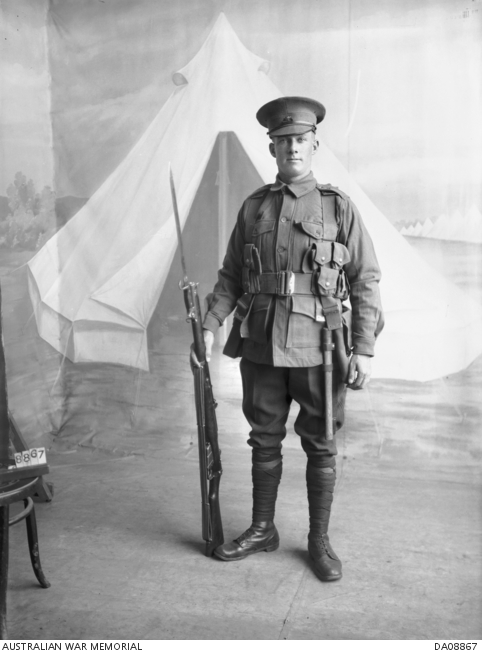Sgt
Albert Eduard Craner
Informationen zu Geburt
|
Geburtsjahr: 1891 |
Informationen zum Armeedienst
|
Land: Australia |
|
Truppe: Australian Imperial Force |
|
Rang: Sergeant |
|
Dienstnummer: 584 |
Informationen zu Tod
|
Sterbedatum: 04/10/1917 |
|
Sterbeort: Retaliation Farm, Zonnebeke, Belgien |
|
Todesursache: Im Kampf gefallen |
|
Alter: 26 |
Begräbnisplatz
|
Buttes New British Cemetery, Polygon Wood Grabstelle: XVIII Reihe: B Grab: 16 |
Auszeichnungen und Orden 3
|
British War Medal Medaille |
|
Military Medal Medaille — 12/06/1916 |
|
Victory Medal Medaille |
Punkte von Interesse 1
| #1 | Ort des Todes (ungefähr) |
Meine Geschichte
Sergeant Albert Edward Craner served in the Australian Infantry 22nd Battalion, part of the 6th Australian Brigade, of the 2nd Australian Division.
On the 4th of October 1917 the 2nd Australian Division participated in the Battle of Broodseinde, a phase in the Third Battle of Ypres. The 22nd Battalion was part of the 6th Brigade, which attacked on the right of the divisional front. The 22nd Battalion would take the first objective, the red line. Once they had taken this line, the 24th would pass through the 22nd on the right and the 21st would do the same on the left. The Battalion assembled before the attack at the jumping-off positions in front of Tokio, but soon moved closer to the road leading to Tokio on account of German artillery fire on and around Albania. They made use of shell holes and old trench systems to form a line.
At 5.35 a.m. moments before the Battalion would attack, the German artillery, including minenwerfers, started shelling the jump-off line, causing heavy casualties. The Germans were about to attack themselves in the hope of recapturing Zonnebeke. The heavy shell fire was very destructive.
At 6 a.m. the British and Australian artillery opened fire on the German positions and the troops started to advance. The 22nd led off, followed by the 21st and 24th. Zonnebeke Lake was on the jumping-off line on the left. The three battalions had to storm the front over 3oo yards right of the lake. Once they had passed the lake the units on the left had to change direction to cover the ground allotted to them.
The German infantry was utterly surprised by the allied barrage. They were quickly dispersed, killed or taken prisoner by the advancing Australians. Docile Trench and De Knoet Farm fell without much opposition and the 22nd Battalion reached their objective by 6.50 a.m. On the right flank of the 24th Battalion the troops met resistance in Romulus Wood, but the Germans were eventually overpowered. At 7.30 a.m. the 21st and 24th moved up behind the protective barrage, reaching the second objective, the blue line at 8.10 a.m., where they dug in and prepared for eventual counterattacks.
Sergeant Albert Edward Craner was killed in action on the 4th of October 1917, close to Retaliation Farm. His remains were exhumed after the war and interred in Buttes New British Cemetery, Polygon Wood.
On the 4th of October 1917 the 2nd Australian Division participated in the Battle of Broodseinde, a phase in the Third Battle of Ypres. The 22nd Battalion was part of the 6th Brigade, which attacked on the right of the divisional front. The 22nd Battalion would take the first objective, the red line. Once they had taken this line, the 24th would pass through the 22nd on the right and the 21st would do the same on the left. The Battalion assembled before the attack at the jumping-off positions in front of Tokio, but soon moved closer to the road leading to Tokio on account of German artillery fire on and around Albania. They made use of shell holes and old trench systems to form a line.
At 5.35 a.m. moments before the Battalion would attack, the German artillery, including minenwerfers, started shelling the jump-off line, causing heavy casualties. The Germans were about to attack themselves in the hope of recapturing Zonnebeke. The heavy shell fire was very destructive.
At 6 a.m. the British and Australian artillery opened fire on the German positions and the troops started to advance. The 22nd led off, followed by the 21st and 24th. Zonnebeke Lake was on the jumping-off line on the left. The three battalions had to storm the front over 3oo yards right of the lake. Once they had passed the lake the units on the left had to change direction to cover the ground allotted to them.
The German infantry was utterly surprised by the allied barrage. They were quickly dispersed, killed or taken prisoner by the advancing Australians. Docile Trench and De Knoet Farm fell without much opposition and the 22nd Battalion reached their objective by 6.50 a.m. On the right flank of the 24th Battalion the troops met resistance in Romulus Wood, but the Germans were eventually overpowered. At 7.30 a.m. the 21st and 24th moved up behind the protective barrage, reaching the second objective, the blue line at 8.10 a.m., where they dug in and prepared for eventual counterattacks.
Sergeant Albert Edward Craner was killed in action on the 4th of October 1917, close to Retaliation Farm. His remains were exhumed after the war and interred in Buttes New British Cemetery, Polygon Wood.
Quellen 3
|
22nd Australian Infantry Battalion, (Australian War Memorial, Campbell (AWM), AWM4 23/39/26). https://www.awm.gov.au/collection/C1338583 Verwendete Quellen |
|
australian war memorial https://www.awm.gov.au/collection/R2004139 Verwendete Quellen |
|
First Australian Imperial Force Personnel Dossiers, 1914-1920, (National Archives of Australia, Canberra (NAA), B2455, CRANER A E). https://recordsearch.naa.gov.au/SearchNRetrieve/Interface/SearchScreens/NameSearch.aspx Verwendete Quellen |
Weitere Informationen 4
|
Commonwealth War Graves Commission Database https://www.cwgc.org/find-records/find-war-dead/casualty-details/480171 |
|
Namenlijst (In Flanders Fields Museum) https://namenlijst.org/publicsearch/#/person/_id=906a0465-ec28-40d8-8cbd-05c0ad6fe40b |
|
Lives of the First World War (Imperial War Museum) https://livesofthefirstworldwar.iwm.org.uk/lifestory/7401992 |
|
The AIF Project (UNSW Canberra) https://aif.adfa.edu.au/showPerson?pid=66188 |
